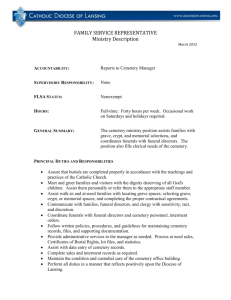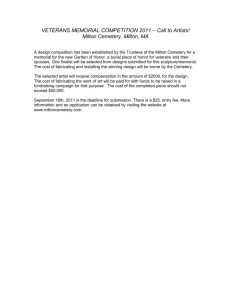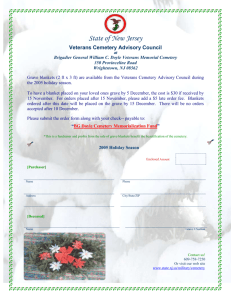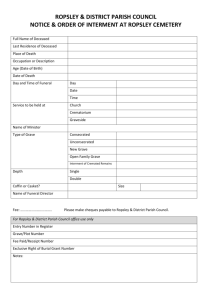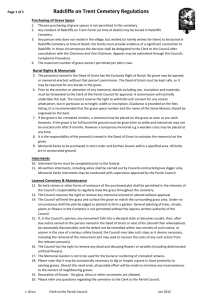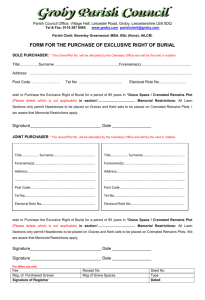Cemeteries - Ubuhlebezwe Municipality
advertisement
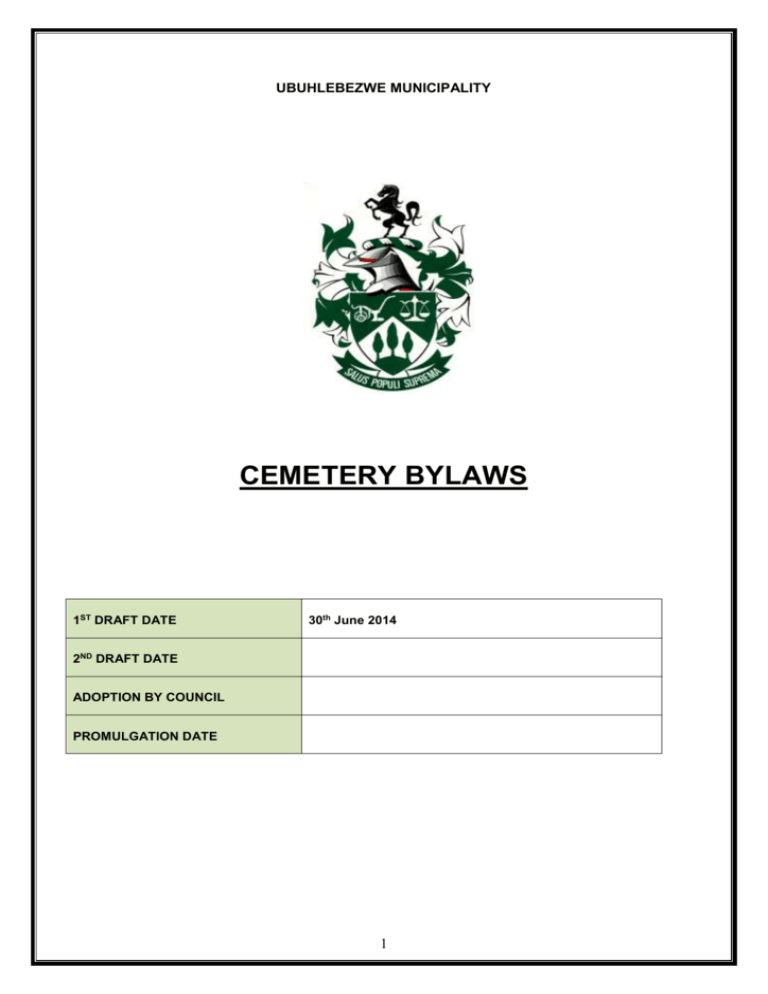
UBUHLEBEZWE MUNICIPALITY CEMETERY BYLAWS 1ST DRAFT DATE 30th June 2014 2ND DRAFT DATE ADOPTION BY COUNCIL PROMULGATION DATE 1 The Municipal Council for Ubuhlebezwe has adopted the following bylaws at its meeting held on in terms of section 156(2) of the Constitution of the Republic of South Africa (Act No 108 of 1996) read with section 31(2) of the Local Government: Municipal Structures Act, 1998 (Act No 117 of 1998) read with section 27 of the KwaZulu Natal Cemeteries and Crematoria Act, 1996 (Act No 12 of 1996) and hereby publishes the subjoined bylaws in terms of section 13(a) of the Local Government: Municipal Systems Act,2000 (Act No 32 of 2000) to come into effect on the date of publication hereof in the Provincial Gazette. Municipal Manager UBUHLEBEZWE MUNICIPALITY CEMETERY LAWS Note: For the establishment or extension of a cemetery or crematorium, the Regulations in terms of the Cemeteries and Crematoria Act, 1996 (Act No 12 of 1996) published on 17 April 1997 under Proclamation No 130 of 1997 are to be consulted. CHAPTER 1 DEFINITIONS 1. Unless the context otherwise indicates: “Act” means the Cemeteries & Crematoria Act, 1996(Act No 12 of 1996) “Adult” means any deceased person over the age of 12 years, whose coffin will fit into the grave opening prescribed for adults in section 40(2); “Ashes” means the physical remains of a body after it has been cremated; ‘Berm” means a concrete strip laid by the Council along a row of graves; “Caretaker” means the person holding the position of caretaker or superintendent of any cemetery or acting in such capacity in the service of the Council; “Cemetery” means any piece of land duly set aside by the Council within the Municipal area for the purpose of a public cemetery; “Child” means any deceased person of the age of 12 years or younger whose coffin will fit into the grave opening prescribed in section 40(2); “Contractor” means the person who has paid any of the tariffs contained in the tariff of charges or who has obtained the right to have any memorial work erected or constructed or who has obtained any rights or interests referred to in these bylaws; “Council” means the Ubuhlebezwe Municipality and its successor in law and includes the Council of that Municipality or its Executive Committee of any other body acting by virtue of any power delegated to it in terms of legislation, as well as any official to whom the Executive Committee has delegated any powers and duties with regard to these bylaws; “Cremation” means the incineration of any human body or its remains to ashes; 2 “Foot Kerb” means the construction on which a memorial works or headstone is attached; “Funerary Vessel” means a container in which cremated remains are placed having a maximum size 280 mm x 170 mm x 105 mm; “Garden of Remembrance” means a section of a cemetery, which has been set aside for the interment or scattering of ashes; “Grave” means any grave in a cemetery in respect of which any person has obtained the right of having a single body interred therein; “Landscape Section” means the section of a cemetery set aside by the council where memorial work is restricted to a plaque or memorial slab; “Lawn Section” means the section of a cemetery set aside by the council in which memorial work is restricted to a headstone only; “Memorial Plate” means a plate of 305 mm x 210 mm x 12/15 mm manufactured of granite or marble attached to the memorial wall over a niche; “Memorial Section” means a section of a cemetery set aside by the council for the erection of memorials; “Memorial Wall” means a wall with niches set out to preserve the funerary vessels against which only memorial plates can be attached; “Memorial Work” means any tombstone, slab, foot-kerb, railing, fence, monument, memorial inscription, plaque or other work erected on any grave; “Municipal Manager” means the official appointed by the Council to this position or any official duly authorized by the Council to act therein; “Niche” means a shallow recess measuring 300 mm x 175 mm x 110 mm in a memorial wall to contain a funerary vessel; “Registrar of Deaths” means any person appointed by the Government of the Republic of South Africa to register deaths; “Resident” means a person who, at the time of death, was ordinarily a resident within the area of jurisdiction of the Municipality, excluding inmates in hospitals, institutions, or other persons temporarily resident within the area of jurisdiction of the Municipality; and “Tariff” means fees payable as determined by the Council from time to time. CHAPTER 2 GENERAL 2. Establishment of Cemeteries 3 Subject to compliance with the National Environment Management Act, 1998(Act No 107 of 1998) and the Cemeteries and Crematoria Act,1996(Act No 12 of 1996), The Council may set aside any land for the purpose of a cemetery and no person shall be permitted to intern a body in any other place, except as is provided for in terms of section 3 (as amended) of the Cemeteries and Crematoria Act, 1996(Act No 12 of 1996) 3. Hours of Admission for Visitors Every cemetery shall be open to the public during the following hours; Mondays to Saturdays: 07h30 to 16h00 and Sundays and Public Holidays: 08h00 to 16h00. The Council shall have the power to close to the public any cemetery or part thereof for such periods as it may deem fit. 4. 5. Reserving of Graves (1) No person shall, without the written consent of the Council, sell or transfer to any other person any right relating to a grave that has been obtained in terms of these bylaws. Should the Council consent to such transfer, it will be subject to the conditions that every transfer of the rights relating to a reserved grave be registered by the caretaker and the registration fee as determined by the Council be paid by the new contractor. (2) Any person having reserved a grave and failing to use the grave within a period of 50 years from the date of reservation, or omitting to notify the Council that he/ she does not intend to use the grave, thus gives the Council the right to sell the grave. The applicable charges as determined by the Council shall be payable in respect of graves sold in terms of this section. (3) The Council shall not be obliged to refund any charges paid in respect of a grave sold in terms of subsection (2). Religious Ceremonies Subject to the provisions of these Bylaws, the members of any religious denomination may conduct religious ceremonies in connection with any interment or memorial service subject to the verbal consent of the Council. 6. Plans of Graves, Plots and Niches Plans indicating the different graves and niches available shall be kept at the Council’s offices for inspection free of charge. 7. Complaints Any person wishing to lodge a complaint concerning the conditions in or the management of the cemetery shall lodge the complaint in writing to the Municipal Manager. 8. Charges/ Tariffs The tariff of charges as determined by the Council, shall be payable to the Council for the services rendered in terms of these bylaws. 4 9. Consent, Notice, or Order Any written consent, notice or order issued by the Council in terms of these bylaws, shall be signed by the Municipal Manager or his authorized representative and shall be prima facie evidence thereof. 10. Instruction of Caretaker Every person taking part in any funeral procession or ceremony in the Cemetery shall obey the instruction/s of the caretaker/ officer in charge. 11. Flowers The caretaker may remove flowers and foliage placed on graves when, in his opinion, they have wilted. CHAPTER 3 PROHIBITION ORDERS 12. Children No person under the age of 12 years may enter any cemetery unless under the supervision of an adult. 13. Keeping to Paths/ Walkways Except for the purposes permitted by these Bylaws, all persons shall only use the roads, paved walkways and demarcated turf walkways provided in the cemetery. 14. Entrances and Exits No person shall enter or leave a cemetery except through the official entrances provided. 15. Performance of Activities No person shall use any road, path or grass route within the cemetery for the purpose of transporting goods, parcels or any other material except if it is intended for use within the cemetery. 16. Prohibited Actions Within Cemeteries (1) No person shall:(a) commit any nuisance within the cemetery; (b) ride on any motorized vehicle, animal, cycle, skateboard or roller skate within any cemetery; (c) allow any animal to wander inside any cemetery; (d) plant, cut, pick or remove any plant, shrub or flower without the permission of the caretaker; 5 17. 18. (e) hold or take part in any demonstration in any cemetery; (f) obstruct, resist or oppose the caretaker or any official employed by the Council in the performance of his/ her duties, or refuse to comply with any order or request which the caretaker is entitled to make in terms of these bylaws; (g) mark, draw or scribble objects on walls or erect advertisements on buildings, fences, gates and memorial work or on anything within any cemetery / or section or deface it in any way; (h) sit, stand or climb on or over any memorial work, gate, wall, fence or building in any cemetery; (i) be in or remain in any cemetery or part thereof before or after the hours mentioned in section 3 or during any period when it is closed to the public; and (j) without the written permission of the Council, tout or operate any business, order, exhibit or distribute any tracts, business cards or advertisements within or at the entrance to any cemetery. Miscellaneous (1) No person shall dispose of a body in any other manner than by interring it in a cemetery or having it cremated in a crematorium approved in terms of the provisions of the KwaZulu Natal Cemeteries and Crematoria Act, 1996 (Act No 12 of 1996). (2) No person shall acquire any right to or interest in any ground or grave in any cemetery, other than such rights or interests as may be obtainable in terms of these bylaws. Exposure No person shall convey a dead body that is not covered, or expose any such body or any part thereof or remove the lid or cover of the coffin wherein such dead body or corpse is placed, in any street, cemetery or public place. 19. Music Inside Cemetery No loud music shall be played in any cemetery without the consent of the Council, except in the case of State, Police or military funerals. 20. Occupation of Chapel or Shelter No person shall for the purpose of a funeral, occupy any chapel or shelter in a cemetery for more than 45 minutes. 21. Hours of Interments 6 No interments shall be held before 9h00 or after 16h00 on any day without the prior consent of the Council. 22. Numbering of Graves No person shall fix a peg or numbered plate on any grave not properly allocated by the Council and no person shall intern a body in any grave on which a peg-marked number or numbered plate has not been lawfully fixed. 23. Rubble and Damage to Cemetery No person shall at any time leave any refuse, soil, stone or any other debris within a cemetery or in any way damage or deface any part of any cemetery or anything therein. 24. Inclement Weather No person shall fix or place any memorial work during inclement weather or while the soil is, in the opinion of the Council, in an unsuitable condition. 25. Disturbance of Human Remains Subject to the provisions of an exhumation order in terms of the Inquest Act, 1959 (Act No 58 of 1959) or any amendment thereof; or section 20 of the KwaZulu Natal Cemeteries and Crematoria Act, 1996 (Act No 12 of 1996) or any amendment thereof; or any other provision of any law relating to the exhumation of bodies, no person shall disturb any mortal remains or any ground surrounding it in any cemetery. CHAPTER 4 INTERMENTS 26. 27. Application for and Acquisition of the Use of a Grave (1) Any person desiring to have a body or human remains interred in a grave shall submit the appropriate form to the caretaker before the time of interment. The next of kin or the closest surviving relative or a person of interest shall sign the application of interment. (2) The Council may, on payment of the applicable fees, allocate the use of any grave appropriated for an interment to any person who has applied for it in terms of subsection (1). (3) No body or human remains shall be interred within any cemetery without the permission of the caretaker. This permission will only be granted on submission of a written burial order, signed by the Registrar of Deaths authorizing the interment, and on presentation and submission of such a notice of interment. In all cases where a postmortem has been held, the order of the magistrate shall also be submitted to the caretaker. (4) The Council may upon request, inter any body free of charge, or in terms of the provisions of any applicable legislation. Alteration of Date of Interment 7 Should any changes to the date or time previously fixed for an interment be made, notice of such changes shall be given to the caretaker at least 24 hours before the interment. For the purpose of this section, 48 hours notice should be given if the aforesaid 24 hours includes a Sunday or part thereof. 28. 29. Dimension of Graves and Grave Apertures (1) The standard dimensions of an adult gravesite shall be 2 500 mm x 1 500 mm and that of a child 1 500 mm x 1 000 mm. (2) The standard dimensions of the aperture of an adult’s grave shall be 2 200 mm in length and 900 mm in width and that of a child’s grave 1 200 mm in length and 700 mm in width. (3) Anybody requiring a grave for the interment of an adult with an aperture larger than the standard size, shall, when applying for the interment, specify the measurements of the coffin and the mountings. The appropriate fee for the enlargement of the aperture will be payable to the Council as prescribed in the tariff of charges. When a Child’s Coffin is Too Large Should a child’s coffin be too large for the aperture of a child’s grave, it shall be placed in an adult grave and the fees payable for an adult’s interment shall apply. 30. Depth of Grave No adult grave shall be less than 1 800 mm and that of a child less than 1 500 mm in depth. 31. Covering of Earth There shall be at least 1m of earth between the coffin and the surface of the ground. In the instance of successive burials, at least 300 mm of earth shall be left between coffins. 32. Coffins in Graves No person shall place any coffin constructed from any material other than wood or other perishable materials approved by the Council, unless otherwise stipulated in other legislation. 33. Number of Bodies in One Grave No more than two bodies shall be buried in the same grave. 34. Reservation of Graves Any person wishing to reserve a grave or upon the death of a person to reserve an adjoining grave, if available, shall obtain the right, on payment of the fees prescribed in the tariffs of charges, to use such grave for future burial purposes. 8 35. Second Interments (1) Any person who wishes to apply for a second interment in the same grave may do so only after a period of two years has lapsed since the date of the first interment on condition that the grave was deepened prior to or during preparation of the grave for the first interment. (2) The applicant who wishes to have a body interred for the purpose of a second interment shall:(a) apply on the prescribed form at least 24 hours before the interment shall take place; and (b) remove any memorial work on such grave at his own cost and comply with any requirements made by the caretaker in this regard. CHAPTER 5 ASHES 36. Acquiring of Niches Subject to the provisions of these bylaws, a person may acquire a niche in any cemetery, if available, and by paying the prescribed fees. 37. 38. Burial of Ashes (1) Subject to the provisions of these bylaws, ashes may be buried in a grave in the cemetery and all prescriptions, provisions and fees applicable in terms of these bylaws pertaining to the burial of a body in a grave are mutatis mutandis. (2) No ashes shall be buried in a grave without it being proved to the satisfaction of the Council as being the cremated remains of a human body and the required documentation is submitted to this effect. (3) Ashes buried in a grave shall be placed in a funerary vessel. (4) There shall be at least 100 mm of earth between the vessel containing the ashes, and the surface of the ground. (5) Subject to the provision of these bylaws, the burial of ashes in a grave being used already for a first interment, may take place free of charge. Placing of ashes in Memorial Wall, Garden of Remembrance or any other section of the cemetery (1) Any person who desires to place a funerary vessel containing cremated remains in a niche in a Memorial Wall, Garden of Remembrance or any other section of the cemetery shall submit an application, accompanied by the Cremation Certificate, in writing or on the prescribed form to the caretaker. If the caretaker is satisfied that the signature of the nearest surviving relative 9 cannot be obtained timeously, he may, in his discretion, grant an application signed by any other person. (2) 39. 40. Any person applying in terms of subsection (1) shall pay the prescribed fees as determined by the Council. Exhumation of Ashes (1) No person shall exhume ashes from any grave without prior written consent or complying with any conditions determined by the Council. (2) Applications for the exhumation of ashes shall be submitted to the Council at least 8 working hours prior to the exhumation. Scattering of Ashes The scattering of ashes in any Landscape Section or Garden of Remembrance is permitted with the prior written consent of the Council. CHAPTER 6 EXHUMATION OF BODIES AND RE-OPENING OF GRAVES 41. 42. Exhumations (1) Subject to the provisions of these bylaws and the Act, no grave shall be reopened without the written consent of the Council, and any organ of State as may be required. (2) Subject to the provision of these bylaws, no person shall exhume or cause any body to be exhumed without the written consent of the Council and the charges for exhumation as determined by the Council shall be paid before the exhumation takes place. Such consent shall be submitted to the caretaker at least two days before the date fixed for the exhumation or removal of the body. (3) Such exhumation shall be performed by the undertaker authorized to do so, under the supervision of the Municipal Manager or person authorized by him to attend the exhumation. Closure due to Exhumation At the time of an exhumation of a body, the cemetery shall be closed to the public. 43. Screening of Activities The grave from which a body is to be removed shall be effectively screened from view during the exhumation and a suitable container shall be supplied for the remains. 44. Council and SAPS Authorised Representative to be Present 10 No exhumation shall take place unless the Council’s and South African Police Services authorized representatives are present. 45. Transfer of Body from One Grave to Another by the Council Subject to the provisions of these bylaws and any applicable legislation, the Council may move a body from one grave to another. CHAPTER 7 CARE OF GRAVES 46. 47. General (1) No shrub, tree or any other plant material may be planted on graves without the consent of the Council and the Council may use its discretion to prune, cut down, dig up or remove any shrub, plant or flower at any time. (2) No person shall bring into a cemetery, erect, alter, paint, clean, renovate, decorate, remove or otherwise interfere with any memorial work or cut any inscription thereon without prior written consent of the Council. Position of Memorial Work No person shall erect any memorials on any grave except in such a position as indicated by the caretaker or as otherwise provided for in these bylaws. 48. Repairs to Memorial Work If a contractor allows the memorial work to fall or cause danger to deface the cemetery in any way, the Council may order him to repair the damage. Should the required repairs not be done within one month of receiving such notice, the Council may carry out these repairs or remove the memorial work without paying any compensation and recover the cost incurred from the contractor. 49. Supervision of Work Any person engaged in any work in any cemetery shall carry out such work under the supervision and to the satisfaction of the caretaker. 50. Damaging of Memorial Works The Council shall not accept responsibility for any damages caused or which may occur which is not due to the negligence of the Council’s employees. 51. Moving of Memorial Work 11 The Council may, after due notice, at any time, change or alter the position of any memorial work in any cemetery. 52. Bringing Material into Cemetery (1) 53. No person shall bring any material into the cemetery for the purposes of constructing any memorial work on any grave unless:(a) a sketch plan indicating the dimensions of the memorial work, the inscription and position thereof has been submitted and approved by the caretaker; (b) all charges due in respect of such grave have been paid; and (c) the Council’s written approval has been given to this effect. Removal of Memorial Works by the Council Any memorial work placed, built, altered, decorated, painted, in contravention of these bylaws or which, in the opinion of the Council, contravenes the good ethics and morals of society, may be removed by the Council after due notice, without payment of any compensation. 54. Requirements for Erection of Memorial Works (1) Any person erecting memorial work shall conform to the following requirements:(a) Where any part of any memorial work is to be joined to any other part, copper or galvanized iron clamps, pins or dowels of approved thickness and of sufficient length, shall be used for such purposes. The holes into which such clamps, pins or dowels must fit shall not be less than 50 mm deep. (b) Any part of such work, which rests upon the ground or stone or other foundation, shall be squared and added. (c) The stones referred to in subsection (1) will not be of uneven thickness nor have uneven corners. (d) The underside of all memorial work shall be set at least 50 mm below the natural level of the ground. (e) No kerbstones shall be used which protrude more than 230 mm above the surface of the ground or are more than 200 mm thick. (f) All head and kerbstones shall be properly secured from the inside with round copper or galvanized iron pins. (g) All headstones up to 150 mm in thickness shall be securely attached to the base in an approved manner. 12 55. (h) All memorial work shall be completed as far as possible before it is brought into the cemetery. (i) No soft stone shall be used for memorial work and memorial work shall be constructed or made of marble or granite or any other approved hard stone. (j) In the case of single graves, foot kerbs shall consist of one solid piece. (k) No person shall do any stonework, chiseling etc. in the cemetery which is not connected with the erection of memorial work, except if the work is expressly permitted in these bylaws. (l) All memorial work shall have an adequate concrete foundation capable of taking the weight of any headstone to be erected and where joints occur in the kerbstones, all joints shall be fitted with good cement mortar. (m) Where memorial work has a base at ground level, such base shall not be less than 900 mm wide by not less than 300 mm x 300 mm. (n) All letters on memorial work shall be engraved thereon and shall not protrude above the surface of the memorial work. (o) With the consent of the contractor, the name of the maker may be affixed to any memorial work, provided that no address or other particulars be added thereto. Vehicles and Tools Any person engaged in any work on any grave shall provide such vehicles, tools and other appliances of his own as he may require. CHAPTER 8 INTERMENT AREAS 56. Division of Cemetery The Council is entitled to divide the cemetery into one or more interment areas or may reserve an area for the burial of a specific religious denomination, provided it has adequate land available for the division of the cemetery or for the reservation of any portion of a cemetery for any religious denomination 57. Memorial Section (1) The following provisions will be applicable to any section which may be designated as a Memorial Section:(a) No person shall, after the expiration of 28 days from the date of any interment, erect, place or leave on or around any grave any railing, wirework, flower stand or other object of any kind. 13 58. (b) No person shall place or leave on a grave any object in the nature of an ornament or embellishment. (c) Flowers, whether natural or artificial, and whether loose or in a vase or wreath, may be placed or left on a grave at any time. (d) Subject to the provision of section 58, memorial work may, with the written consent of the council, be erected on any grave. (e) No kerbstones shall be laid in such a manner so as to be more than 230 mm above the surface of the ground and more than 200 mm deep, without the written consent of the Council. (f) All kerbstones shall be properly dowelled and shall be fixed as to permit their easy removal without danger of damaging the headstones or other memorial work on the grave. (g) The standard dimensions of a memorial work for one single gravestone for an adult are 2 500 mm x 1 050 mm. (h) The standard dimensions of a memorial work for a double memorial work for adults are 2 500 mm x 2 550 mm. (i) The standard dimensions of a memorial work for children’s memorial work are 1 500 mm x 900 mm. Lawn Section (1) The following provisions will be applicable to any section which may be designated as a Lawn Section:(a) Except during the first 28 days after an interment and subject to subsection (5), no person shall erect, place or leave on or around a grave any railings, wirework, flower stands, ornament, embellishment or other object of any kind. Provided that during the first six months after an interment flowers, whether natural or artificial and whether loose in wreaths, may at any time be placed or left on the berm or at the head of the grave or where no berm has been provided, anywhere on the grave. (b) A headstone in the lawn section shall not exceed 1 070 mm above the berm or ground level, as the case may be, and shall not exceed the width of the berm. (c) The dimensions of the base of a headstone shall not exceed 600 mm x 250 mm and the position of the base on a berm shall be such that the edge thereof nearest to the grave shall be at least 120 mm from the edge of the berm, provided that the base of a headstone erected over two adjoining graves may exceed 600 mm in width but shall not exceed 1 200 mm x 250 mm. 14 (d) 59. Requirements for Memorial Work in any Lawn Section (1) 60. In the lawn section, a receptacle approved by the caretaker or a vase may be placed in the cavity in the berm provided for this purpose. Such vase or receptacle shall be at least 380 mm in height and shall not exceed the perimeter of the said cavity. The following provisions are applicable to memorial work and graves in any Lawn Section:(a) Headstones shall be a maximum of 1 500 mm in height, 910 mm in width and with a length of 250 mm. (b) No kerbstones demarcating any grave and no flat slab covering any grave shall be allowed. (c) The foundation of a gravestone erected or laid over any single grave shall be at the most 910 mm x 380 mm and at least 300 mm (depth) in size. (d) The base of a gravestone erected over any single grave shall be at the most 910 mm x 250 mm x 250 mm in size. (e) The foundation of any single gravestone erected or laid over two continuous graves shall be at the most 2 130 mm x 380 mm and at least 300 mm (depth) in size. (f) The base of any single gravestone erected or laid over two continuous graves shall be at the most 1 830 mm x 250 mm x 250 mm in size. (g) In order to make provision for the fitting of a number plate, two holes of 6 mm in diameter and 30 mm depth shall be made 500 mm from each other on the foundation of every grave and in such a manner that both holes shall be in the middle of the foundation and 40 mm from the border of the foundation on the grave side. (h) A single gravestone shall not be erected or laid over more than two continuous graves. (i) The Council will maintain and decorate, as it deems fit and free of charge, the graves by planting flowers, shrubs or grass. Landscape Section (1) The following provisions will be applicable to any section which may be designated as a landscape area:(a) No person shall place, build, erect or plant anything, including memorial work and flowers on, around or next to any grave, provided that flowers and wreaths may be placed on a grave during the first month following interment. 15 61. (b) Anything that is placed, built, erected or planted on or around or next to a grave or flowers or wreaths that are still on a grave one month after interment, in contravention of subsection (1), may be removed by the Council and be destroyed or otherwise disposed of. (c) The standard dimensions of a grave for an adult are 2 500 mm x 1 500 mm and for a child 1 500 mm x 1 000 mm. (d) The standard dimension of the aperture of a grave for an adult is 2 200 mm in length and 900 mm in width and that of a child 1 200 mm in length and 700 mm in width. (e) Any person who requires a grave for the interment of an adult with an aperture larger than the standard size, shall when applying for the interment, specify the measurements of the coffin including the mountings. (f) A marble or granite memorial slab or a plaque of 305 mm x 210 mm x 12/15 mm in dimension may be placed on a grave in any Landscape Section. (g) A memorial slab or plaque is placed horizontally on a concrete slab with dimensions of 355 mm x 260 mm x 150 mm (in thickness) with the eventual height level with the ground. (h) Memorial slabs or plaques are placed in the middle of the grave stand so that eventually all memorial slabs or plaques form straight lines. (i) No permanent vases or containers shall be attached to a memorial slab or plaque in any Landscape Section. (j) Charges payable are as determined by the Council. (k) No additional charges are levied for a second interment in any Landscape Section. (l) Only one memorial slab or plaque per grave is allowed in any Landscape Section. (m) The Council may develop the area as a park and maintain it accordingly. Memorial Wall (1) A funerary vessel containing cremated remains may be placed in a niche in the Memorial Wall, provided that:(a) a maximum of two vessels may be placed on one niche; (b) the maximum dimension of a funerary vessel is 175 mm x 185 mm x110 mm; and (c) the tariff(s) as determined by the Council are paid. 16 62. (2) A marble or granite memorial plate is placed over a niche; provided that such memorial plate does not exceed 305 mm x 210 mm x 12/15 mm in dimension. (3) Durable, non-rust metal, glass of plastic vases may be placed next to a marble or granite memorial plate, provided that the application is approved by the Council and complies with the following standards:(a) Size of vase 40 mm wide x 100 mm high and manufactured from durable, non-rust metal, glass or plastic. (b) Fixing of vase. The fixing shall take place by way of a durable, non-rust metal plate affixed against the wall with screws. The top portion of the plate shall be rectangular bent to the front with the vase attached. (c) Dimensions of the plate 20 mm x 2 mm thick x 55 mm long. The total length of metal strip preparatory to bending should be 125 mm. (d) Position for attaching vases. Vases will be attached to the right of the marble memorial plate with the lower point of the attachment plate in line with the lower side of the memorial plate. A gap of 20 mm shall be left open between the memorial plate and the attachment plate. Garden of Remembrance (1) A funerary vessel containing cremated remains may be placed in the ground in any Garden of Remembrance, provided that:(a) the standard dimension of a burial site for cremated remains is 500 mm x 500 mm; (b) the standard dimension of the aperture for the burial of cremated remains is 400 mm x 200 mm x 200 mm; (c) the standard dimension of a marble or granite memorial plate is 410 mm x 210 mm x 15 mm and may be placed on such grave in any Garden of Remembrance; (d) a memorial plate is placed horizontally on a concrete slab with dimensions 420 mm x 220 mm x 50 mm (in thickness) with the eventual height level with the ground; (e) memorial plates are placed in the middle of the grave stand so that eventually all memorial plates form straight lines; (f) no permanent vases or containers shall be attached onto any memorial stone in the Garden of Remembrance; (g) charges are payable as determined by the Council from time to time; (h) no additional charges are levied for a second interment on the same burial site in the Garden of Remembrance; and 17 (i) only one memorial plate per grave is allowed in the Garden of Remembrance; CHAPTER 9 OFFENCES, PENALTIES AND APPEALS 63. The provisions of the council’s Bylaws Relating to Offences, Penalties and Appeals shall apply mutates mutandis to these bylaws. CHAPTER 10 REPEAL OF BYLAWS / REGULATIONS 64. The following Bylaws/ Regulations are hereby repealed. The Cemetery Regulations adopted by the former Ixopo Health Committee under Provincial Notice No 6 of 1949 dated 6 January 1949. PART R III Establishment and Maintenance of Cemeteries of the former Development and Services Board in so far as these were applicable to the under mentioned area, shall no longer apply from the date of promulgation of this notice in the Gazette: Regulated Area: Stuartsville 18
